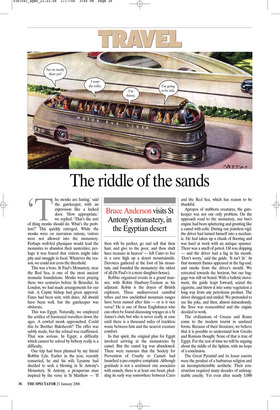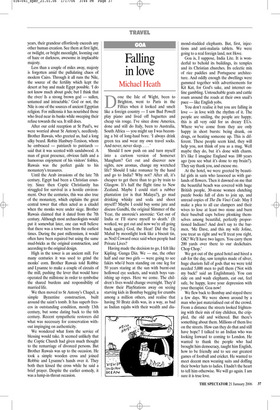The riddle of the sands
Bruce Anderson visits St Antony’s monastery, in the Egyptian desert
‘T he monks are fasting,’ said the gatekeeper, with an expression like a locked door. ‘How appropriate,’ we replied. ‘That’s the sort of thing monks should do. What’s the problem?’ This quickly emerged. While the monks were on starvation rations, visitors were not allowed into the monastery. Perhaps well-fed physiques would lead the monastics to abandon their austerities; perhaps it was feared that visitors might take pity and smuggle in food. Whatever the reason, we could not cross the threshold.
This was a bore. St Paul’s Monastery, near the Red Sea, is one of the most ancient monastic foundations. Monks were praying there two centuries before St Benedict. In London, we had made arrangements for our visit. A Coptic bishop had given approval. Faxes had been sent, with dates. All should have been well, but the gatekeeper was obdurate.
This was Egypt. Naturally, we employed the artifice of frustrated travellers down the ages. A cowled monk approached. Could this be Brother Baksheesh? The offer was subtly made, but the refusal was reaffirmed. That was serious. In Egypt, a difficulty which cannot be solved by bribery really is a difficulty.
Our trip had been planned by my friend Robbie Lyle. Earlier in the year, recently remarried, he and his wife Lysanne had decided to seek a blessing in St Antony’s Monastery. St Antony, a prosperous man inspired by the verse in St Matthew — ‘If thou wilt be perfect, go and sell that thou hast, and give to the poor, and thou shalt have treasure in heaven’ — left Cairo to live in a cave high up a desert mountainside. Devotees gathered at the foot of his mountain, and founded the monastery: the oldest of all (St Paul’s is a mere daughter-house).
Robbie organised events in a grand manner, with Robin Hanbury-Tenison as his adjutant. Robin is the doyen of British explorers. Three undiscovered cannibal tribes and two unclimbed mountain ranges have been named after him — or is it vice versa? He is one of those Englishmen who can often be found discussing voyages in a St James’s club, but who is never really at ease until there is a thousand miles of trackless waste between him and the nearest creature comfort.
In that spirit, the original plan for Egypt involved arriving at the monasteries by camel. But the camel leg was abandoned. There were rumours that the Society for Prevention of Cruelty to Camels had launched a pre-emptive complaint. Although gratitude is not a sentiment one associates with camels, there is at least one beast, plodding its surly way somewhere between Cairo and the Red Sea, which has reason to be thankful.
Apropos of stubborn creatures, the gatekeeper was not our only problem. On the approach road to the monastery, our bus’s engine had been spluttering and grunting like a camel with colic. During our pointless vigil, the driver had turned himself into a mechanic. He had taken up a chunk of flooring and was hard at work with an antique spanner. There was a smell of petrol. Oil was dripping — and the driver had a fag in his mouth. ‘Don’t worry,’ said the guide. ‘It isn’t lit.’ At that moment flames appeared at the fag-end, and smoke from the driver’s mouth. We retreated towards the horizon, but our baggage was still on board. With a balletic movement, the guide leapt forward, seized the cigarette, and threw it into some vegetation a long way from any petroleum product. The driver shrugged and smiled. We pretended to see the joke, and then, almost miraculously, the floor was reassembled and the engine decided to work.
The civilisations of Greece and Rome come to the modern tourist in sanitised forms. Because of their literature, we believe that it is possible to understand how Greeks and Romans thought. None of that is true of Egypt. For the rest of time we will be arguing about the riddle of the Sphinx, with no hope of a conclusion.
The Great Pyramid and its lesser escorts were the product of a barbarous religion and an incomprehensible aesthetic. Their construction required many decades of unimaginable cruelty. Yet even after nearly 5,000 years, their grandeur effortlessly exceeds any other human creation. See them at first light, or twilight, or bright moonlight, looming out of haze or darkness, awesome in implacable majesty.
Less than a couple of miles away, majesty is forgotten amid the pullulating chaos of modern Cairo. Through it all runs the Nile, the source of the fertility which kept the desert at bay and made Egypt possible. ‘I do not know much about gods; but I think that the river/ Is a strong brown god — sullen, untamed and intractable.’ God or not, the Nile is one of the sources of ancient Egyptian religion. For millennia it has nourished those who lived near its banks while sweeping their refuse towards the sea. It still does.
After our cold reception at St Paul’s, we were worried about St Antony’s, needlessly. Brother Ruwais, who greeted us, had a long silky beard. Robin Hanbury-Tenison, whom he embraced — patriarch to patriarch said that it was scented with sandalwood. A man of great presence, obvious faith and a humorous enjoyment of his visitors’ foibles, Ruwais was the perfect guide to his monastery’s treasures.
Until the Arab invasions of the late 7th century, Egypt had been a Christian country. Since then Coptic Christianity has struggled for survival in a hostile environment. Over the centuries, this was also true of the monastery, which explains the great central tower that often acted as a citadel when the monks were under siege. Brother Ruwais claimed that it dated from the 7th century. Although most archaeologists would put it somewhat later, one can well believe that there was a tower here from the earliest times. During the past millennium, it would often have been repaired but using the same mud-bricks as the original construction, and according to the original design.
High in the tower is an ancient mill. For many centuries it was used to grind the monks’ corn. Brother Ruwais told Robbie and Lysanne to make a couple of circuits of the mill, pushing the lever that would have operated the millstone in order to symbolise the shared burdens and responsibility of married life.
We then moved to St Antony’s Chapel, a simple Byzantine construction, built around the saint’s tomb. It has superb frescos in outstanding condition, mostly 13th century, but some dating back to the 6th century. Recent sympathetic restorers did what was necessary for conservation without impinging on authenticity.
We wondered what form the service of blessing would take. It seemed unlikely that the Coptic Church had given much thought to the remarriage of divorced persons. But Brother Ruwais was up to the occasion. He took a simple wooden cross and joined Robbie and Lysanne’s hands over it. They both then kissed the cross while he said a brief prayer. Despite the earlier comedy, it was a lump-in-throat occasion.




















































 Previous page
Previous page